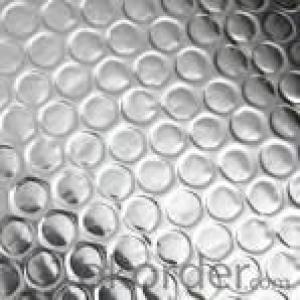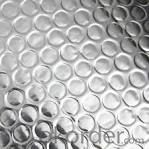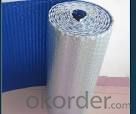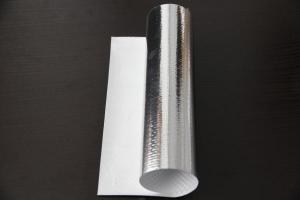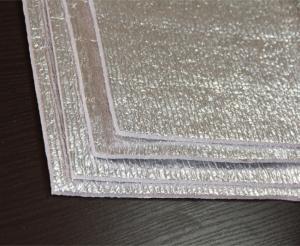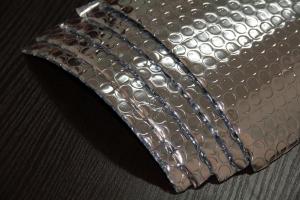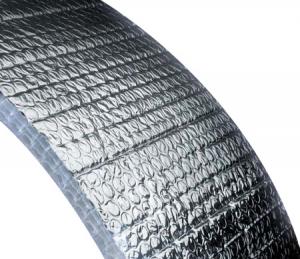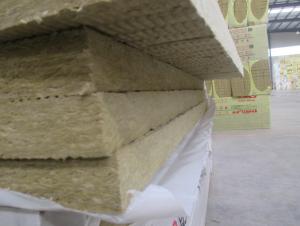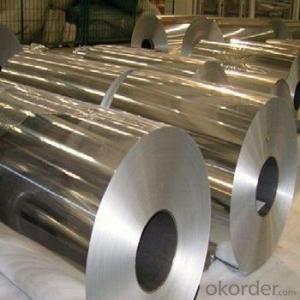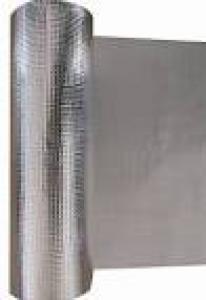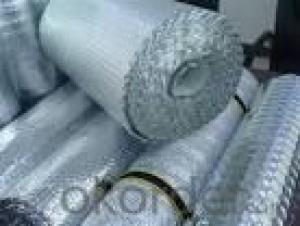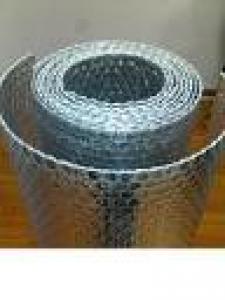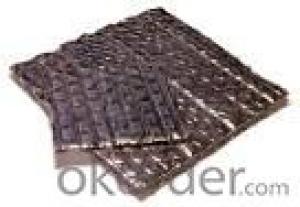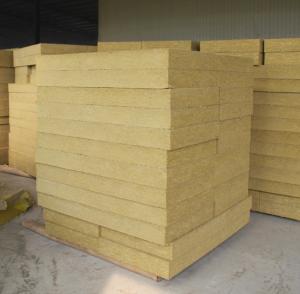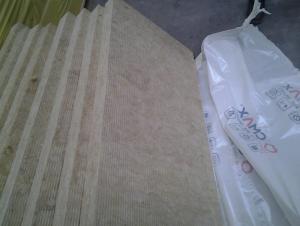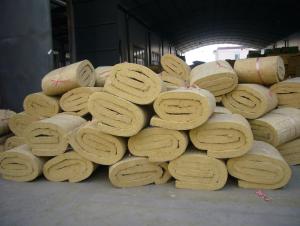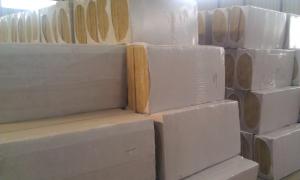Decatur Al Residential Roofing Insulation - Aluminum Foil Coated Bubble Type 11
- Loading Port:
- Shanghai
- Payment Terms:
- TT OR LC
- Min Order Qty:
- 10000 m²
- Supply Capability:
- 100000 m²/month
OKorder Service Pledge
OKorder Financial Service
You Might Also Like
Bubble Insulation Benefits:
Reflects 96% of radiant heat
Non-toxic / Non-carcinogenic
Does not require protective clothing or respirators to install
Durable and lightweight
Does not compress, collapse or disintegrate
Vapor and radon retarder
Easy to cut and install
Permanent and maintenance-free
Does not provide a growth medium or nutritive value for fungus, insects, or rodents
Does not support the growth of mold or mildew
Not affected by moisture or humidity
Lowers heating and cooling costs year round
Bubble Foil Application:
Metal & Steel Buildings
Homes
Roof Underlayments
Cathedral Ceilings
Crawl Spaces
Hot Water Heaters
Basement Walls
Floors
Garage Doors
Concrete slabs
Driveway snow melts
Pole barns
Post frame buildings
Poultry barns
Animal kennels
Temperature sensitive storage areas
Air Bubble Foil Insulation Tech Data:
Material Structure: AL/Bubble/AL | ||
Bubble Size:D10mm*H 4mm(10*2.5/10*4/10*6/20*7/25*10)choose the bubble size | ||
Bubble Weight:0.13kg/m2 ( can be customized ) | ||
Roll Width:1.2m (lenth can be customized) | ||
PROPERTIES | TEST DATA | UNIT |
Thickness | 3.5-4 | mm |
Weight | 250 | g/m2 |
Emissivity | 0.03-0.04 | COEF |
Thermal conductivity | 0.034 | w/m0 |
Apparent Density | 85 | kg/m3 |
Reflectivity | 95-96 | % |
Water Vapour Transmission | 0.013 | g/m2kpa |
Corrosion | doesn't generate | |
Tensile Strength(MD) | 16.98 | Mpa |
Tensile Strength(TD) | 16.5 | Mpa |
- Q: the noise when it rains is very loud. can I place an insulation material under the polycarbonate roof to reduce noise? Thanks
- You can put it up there, but it's effectiveness at cutting noise would depend on the thickness of the insulation but you should not hope for too much reduction as the hard poly roofing is screwed or nailed directly to the rafters and is a good medium for sound transference.
- Q: I know you're not supposed to directly insulate the roof due to the roof getting super heated in the summer, but my walk-in (actually, more like "crawl in") attic is very hot in the summer and very cold in the winter. Is there anything I can do to improve efficiency? I can't help but think I'm wasting a lot of energy just to keep my roof lasting a little longer.
- You can avoid the condensation problem by simply leaving a minimum 2'' gap between the roof and the insulation. You need to fix battens on to the rafters ( at least 2'' from the tiles ) and then fix blanket or rigid insulation tight between them. The battens will maintain the air space. You then need to fix a vapour barrier over the whole thing and finish with plasterboard. No small job to do it properly ! ps you need to check the condition of the roof before you start and fix any loose tiles etc Alternatively, turn the heating up and wear a thicker sweater.
- Q: ... building code max. (R-50)???
- Anytime snow melts from a roof due to lost heat from the interior, or sun shining on the roof, but air is below freezing, icecycles will form. The real danger here is ice cycles that can fall when thawing and kill in extreme cases, AND ice dams can form forcing ice back up under shingles damaging roof. That is why it is often a good idea to install heat tape under the edge of roofs in areas that are prone to heavy freezes and snow.
- Q: what action should a plumber take?????
- struggling to understand your question! are you talking about a storage tank? what is the problem with the insulation? if it is in the way move it but insulation under a tank is not a problem the tank will need to be insulated any way!
- Q: Our end unit 1940"s row house has an old leaking bitumen roof . The water entry point can not be found so a replacement seems the way to go. A roofer suggested a replacement using Firestone 180, 1/2 inch fiberboard insulation covered with fiberglass base sheet, bitumen for flashing and fibered aluminum coating on wall coping . It's all Greek to be but fiberboard insulation and flashing material ? Should I be concerned?
- We use kingspan insulation, marine grade plyboard , 3/4 inch, and yes you can use bitumen as flashing. I hope i am not being condescending, but the flashing is the bit that goes from the roof and a little way up the wall and is then "pointed" into the bricks, thus forming a water-proof barrier.
- Q: So I'm renovating an old farmhouse with a metal roof and there is no insulation in the attic. I was up in the attic checking for leaks since we just got some freezing rain and it is currently melting I thought now was the perfect time to check. I found no leaks but I did notice the roof was sweating with noticeable beads of water in many places and many of the 2x4's that act as the frame were damp, although none were rotted (I found that odd as the house is approx. 140 years old and those are the original 2x4's. I could tell that the attic does have vents so I guess it dries out before rotting or mold occurs.. but makes me wonder if I put down some roll-in faced R-30 Owens Corning Insulation and then add a plywood floor over top if everything will be fine.. or not so fine..
- I own an 80 year old house -- a home originally built as temporary housing for people working in the airplane industry during the war, and for returning soldiers. Temporary housing that is better structurally than many new homes. In fact, the original design and work was brilliant in its simplicity and precision, and I have found that the problems with my house are the result of work done later on -- additions and fix ups that screwed with the original integrity. One thing I have learned RE old houses is it is often best to leave well enough alone. This does not mean one should not address definite problem, or add certain features, but it does mean one has to think things through and do a great deal of research before acting. As you say, the structure of the roof is the original, so all the folks who had the house before you must have been doing something right. If I were you, I would ask around my community, do some internet searches, and find someone in your area who is an expert on dealing with historical structures of the area. This person will not necessarily be a master craftsman with a PhD in history and another in architecture. It may actually be a skilled handyman or carpenter who is continuing the old family business. He also probably lives in an old farm house, or knows plenty of folks who do. THAT is the guy you want to consult.
- Q: A roofer who wants to put a new roof on my mobile home says it will dry out. (We live in the rainiest part of the US)
- If your insulation gets wet while the roof was removed, you will most likely have mold/mildew problems after the roof is replaced. While the roof is off, it's an excellent idea to inspect the insulation are replace as necessary. If your roofer isn't going to protect your insulation while it is exposed, find another roofer.
- Q: Hi, I have got a physics question and was just wondering about it.. Can someone pls tell me how does roof insulation work? how is it effective? How does the insulation changes the heat circulation and transfer inside a house?I know that the insulation prevents radiation from the sun and overheating.. but any more details about radiation, convection and conduction of heat pls?
- Well insulation makes a dead air space (air is stagnant). Since the air is not moving the transfer of hot and cold is slowed down considerably. But since you have to create cross ventilation to reduce rotting in wood and the build up of explosive gasses. Its a crap shoot that it even does any good. Radiation is heat so that's covered by the dead air space. Convection is usually not an issue with the cross venting. Also for conduction the insulation should slow it down considerably.
- Q: we want to put a model railway up in the loft,and i like the idea of having white plastic cladding throughout up there,my hubby is insulating the roof tomorrow,but he prefers plasterboard,at least the cladding will be maintenance free,
- i think it might be able to pass code if you ever sell the house.i myself would use sheets of white wainscoting.also make sure the insulation if it has a paper backing ,paper faces the room.
- Q: I would like to know which direction the one side with foil faces. The roof or the interior of the room?This is an attic room. Roof being "raw" i mean that it looks like cedar tongue in groove boards...then shingles on top of them. Which way do i face the foil side of the sheet..?thanx
- The foil side should go to the outside. I believe it's a moisture barrier.
Send your message to us
Decatur Al Residential Roofing Insulation - Aluminum Foil Coated Bubble Type 11
- Loading Port:
- Shanghai
- Payment Terms:
- TT OR LC
- Min Order Qty:
- 10000 m²
- Supply Capability:
- 100000 m²/month
OKorder Service Pledge
OKorder Financial Service
Similar products
Hot products
Hot Searches
Related keywords
